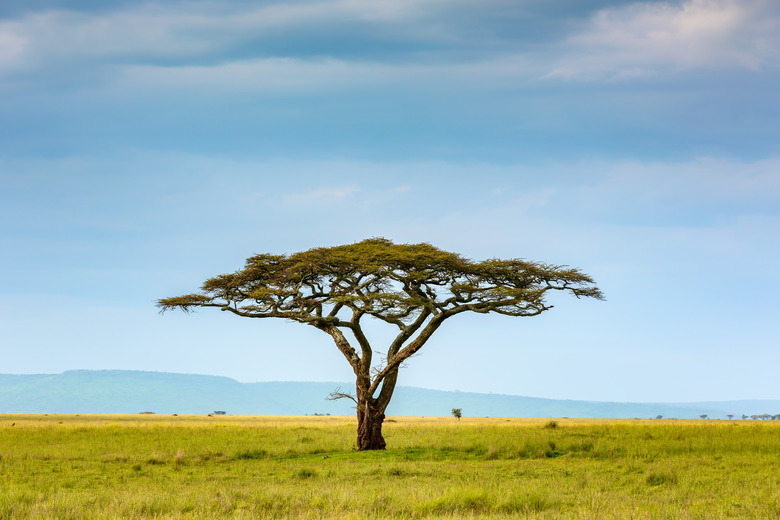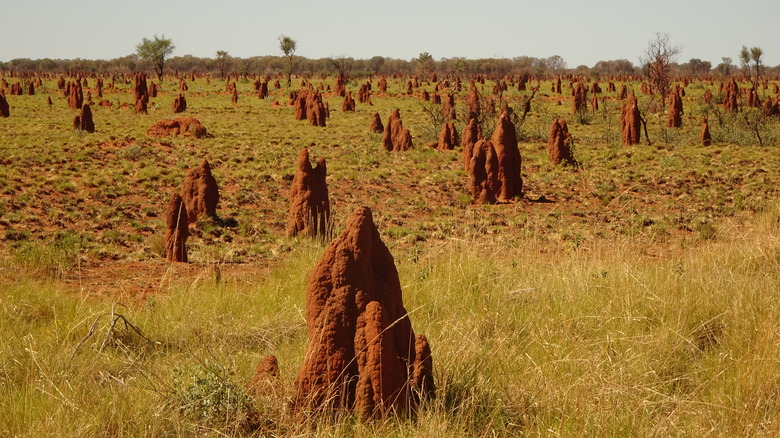Insects And Flowers In Savanna Grass
Savannas are vast grassland biomes scattered with trees. Nearly half of Africa is covered in savannas. Large areas of savannas are also found across South America, India and Australia. Though savannas may look like a monoculture of grass from a distance, there is actually an abundance of different plant species and insects in grasslands.
Insects in Grasslands
Insects in Grasslands
Insects are a vital part of grassland ecosystems. Insects aerate the soil, pollinate plants and provide food for other grassland animals. Termites (Isoptera infraorder), ants (Formicidae family), beetles (Coleoptera order) and grasshoppers (Caelifera suborder) are the more well-known insects in grasslands.
Termite Mounds
Termite Mounds
Colonies of mound-building termites create large structures out of dirt above their nests. These mounds are affectionately called "skyscrapers of the savanna" as they can reach a whopping 30 feet high.
Inside their nests, termites farm a fungus (Termitomyces spp.) which they use to help break down plants and wood, making it more nutritious and easily digestible. This process produces a lot of carbon dioxide. The intricate mounds act as a natural ventilation system for the nest, swapping carbon dioxide for oxygen throughout the day while also buffering against the extreme savanna temperature and humidity changes.
Dung Beetles
Dung Beetles
Dung beetles of the family Scarabaeidae fly around the savanna, searching for large mammals' fresh dung. Using specialized mouthparts, the beetles suck nutritious liquids containing microorganisms from the dung. Most dung beetles feast on dung from herbivores, however, some species eat dung from carnivores.
Animal dung also plays a vital role in dung beetle reproduction. Male roller dung beetles make the feces into a large ball to attract a female. After pairing, the female rides on top of the ball while he pushes it or they roll it away together, then bury it and lays their eggs inside. Other species tunnel through a pat of dung then lay eggs or lay their eggs on top. The dung beetle larvae, called grubs, eat the solid dung particles set aside by their protective parents.
Many species of dung beetles have a unique level of parental care compared to the rest of the insect world. Often mother dung beetles will stay with her grubs for months, protecting and cleaning them. Ball dung beetles may stay with their grubs for up to two months. Tunneling dung beetles can stay with their grubs for up to four months until the grubs mature.
Mutualistic Relationships
Mutualistic Relationships
Ants and acacia (Acacia spp.) trees of the savanna have developed a unique mutualistic relationship. The branches of acacia trees are covered in sharp thorns to help deter grazing by large mammalian herbivores such as giraffes (Giraffa spp.), elephants (Proboscidea order) and goats (Capra spp.). At the base of these thorns are bulbous swellings, called domatia, in which ants eat holes through the sides and make nests. The ants fiercely attack any mammalian herbivores that try to eat the tree to protect their homes, further helping the acacia protect itself from being eaten.
In addition to pointy thorns and vicious ants, the African whistling thorn acacia (A. drepanolobium) has another defense tactic. The holes created by the ants in the sides of the domatia create a whistling sound when the wind blows. This whistling is thought to act as a warning signal, called auditory aposematism, for herbivorous mammals telling them not to attempt to eat it, or else they will be spiked and attacked by ants. Auditory aposematism is poorly studied in plants but works as a defense in the same way as a rattlesnake (Crotalinae subfamily) makes its signature warning sound with its tail to scare off predators.
Wind-Pollinated Savanna Flowers
Wind-Pollinated Savanna Flowers
Grass savanna flowers of the Poaceae family rely on wind pollination. Since wind-pollinated flowers don't need to attract animals, they tend to have simple colors, lack fancy petals or scents, and are exposed to the elements. For example, the flower stems of elephant grass (Pennisetum purpureum) are the tallest part of the plant, typically growing between 6.5 and 13 feet fall but sometimes growing as tall as 24.6 feet.
Insect-Pollinated Savanna Flowers
Insect-Pollinated Savanna Flowers
Some savanna plants have evolved reward systems to attract insect pollinators. For example, acacia flowers are small and bunched with a vast number of stamens, which deliver pollen, compared to stigmas, the female part of a flower. Excess pollen is produced to act as a reward for bees (Anthophila clade). While the bees busily collect the acacia tree's pollen for food, some pollen will fall off their body at each new flower to facilitate cross-pollination.
References
- Brisbane City Council: Elephant Grass
- CABI: Pennisetum Purpureum
- BBC Earth: Why Termites Build Such Enormous Skyscrapers
- National Geographic Kids: Dung Beetle
- San Diego Zoo Wildlife Alliance: Dung Beetle
- Plant Signaling & Behavior: Does the Whistling Thorn Acacia (Acacia Drepanolobium) Use Auditory Aposematism to Deter Mammalian Herbivores?
- University of California Museum of Paleontology: The Grassland Biome
- NASA Earth Observatory: Grassland
- Arizona State University: Ask a Biologist: Grass Patches... and a Few Trees
Cite This Article
MLA
Jerrett, Adrianne. "Insects And Flowers In Savanna Grass" sciencing.com, https://www.sciencing.com/insects-and-flowers-in-savanna-grass-13426368/. 30 September 2021.
APA
Jerrett, Adrianne. (2021, September 30). Insects And Flowers In Savanna Grass. sciencing.com. Retrieved from https://www.sciencing.com/insects-and-flowers-in-savanna-grass-13426368/
Chicago
Jerrett, Adrianne. Insects And Flowers In Savanna Grass last modified March 24, 2022. https://www.sciencing.com/insects-and-flowers-in-savanna-grass-13426368/

